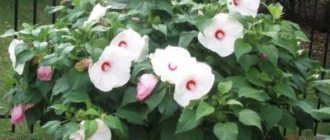Which varieties are suitable for growing in the garden?
Those varieties that can easily tolerate temperature changes, frosts, and long rains include garden hibiscus (Syrian) and hybrid hibiscus, which can either be planted in the countryside or decorate the landscape of a country house with them.
Hibíscus syríacus (Syrian bush)
- Diana;
- Vayelit Ilar Double;
- Pink Giant;
- Carneus Plenus;
- Joan of Arc.
Hibiscus hybridus (Hybrid herbaceous)
- Youth;
- Late;
- Pale pink;
- Pink porcelain.
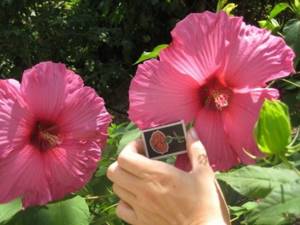
Hibiscus planting and care in open ground
Growing garden hibiscus does not bring much trouble, but if you do everything correctly, you will have a successful result.
Hibiscus requires regular moderate watering as the soil dries out. In hot weather, water frequently, but do not allow moisture to stagnate.
To plant garden hibiscus in open ground, it is necessary to prepare loose soil, saturated with humus fertilizers and without stagnant moisture. The garden hibiscus flower requires constant loosening of the soil and removal of weeds around it.
During the period of active development from the first months of summer to autumn, hibiscus needs regular fertilizers with a high content of nitrogen and phosphorus. It should be fed several times a month, and closer to winter, potassium fertilizers should be added. Hibiscus inflorescences bloom for only one day.
You can also get acquainted with the indoor hibiscus plant and what care it needs to provide at home by clicking on the link.
Flower in the photo
Blooming hibiscus looks very delicate and substantial at the same time:
How to choose a suitable place in the country?
- Lighting. Hibiscus loves light, so the best place for it in a garden plot would be a well-lit area, but without direct sunlight, which can cause leaf burn.
- Temperature. Garden hibiscus grows in open ground, so it tolerates any temperature in the warm season.
But it is important that the hibiscus is planted in a place that is protected from wind and drafts. But in order for the hibiscus to survive the winter with its frosts, you need to take care of it. If winter is expected, the maximum temperature of which will be -15C, then a frame should be built around the plant, on which spunbond or agrotex should be stretched. If the winter is expected to be harsh, then it is better not to risk it and, having dug up the hibiscus, give it the opportunity to overwinter in the basement or other cool room. - Priming. The main requirement for soil is that it must be nutritious, light, and permeable. Any peat-based substrate will meet these characteristics. To plant hibiscus, you can use a mixture of garden soil, peat, sand in a ratio of 2:4:1. Another mixture is also possible: turf, leaf soil, humus, coarse sand in a ratio of 2:2:1:1. Alternatively: 5% perlite, 45% hardwood bark, 50% peat.
- Soil preparation. The planting hole should be 2 times the volume of the plant’s root system. The bottom layer is drainage (broken brick), its height should be at least 15 cm. The next layer, 10 cm high, is sand. Next - 15 cm of compost. The top layer is 15 cm – sand. After placing the root system of the plant in the planting hole, the entire space is filled with soil.
Reference! The best neighbors for hibiscus in a personal plot are rose and lavender. They have the same requirements for the composition of the soil as roses, and lavender will not only highlight hibiscus favorably, but will also be an excellent protection for it from aphids, which cannot tolerate the lavender smell.
Hibiscus garden care and propagation
When to plant garden hibiscus?
Before planting, think carefully about where your hibiscus will grow, since the choice of location determines how long the plant will decorate your garden - with the right site and good care, hibiscus will grow in one place for up to 20 years! Hibiscus seedlings are planted in the spring, when the danger of night frosts has passed, so that they can take root and grow stronger over the summer. The ideal space for hibiscus would be a clear, wind-protected space with light, fertile, moisture-proof soil - the kind in which roses are great to plant. You can generally place hibiscus in the middle of roses and they will get along just fine.
Reproduction methods
You can propagate hibiscus in the garden in a whole list of ways , you just need to choose an available option and read the detailed guide on how to plant the plant.
Cuttings
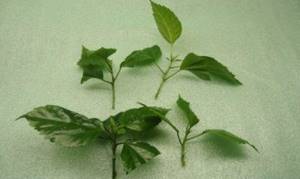
Step-by-step landing instructions:
- Prepare everything you need:
- container made of dark plastic or glass;
- stalk;
- activated carbon tablet;
- a little growth stimulant;
- greenhouse
- Fill the container with settled water at room temperature (2/3 full).
- Add an activated carbon tablet to the water and dissolve the root formation stimulator in it.
- Dip the cutting into water.
- The top of the container with the shoot must be covered with a greenhouse.
- Place the vessel in a warm (+20C – +25C) and bright place (but without direct sunlight).
- Sometimes you need to open the greenhouse slightly and shake off drops of condensation from its walls.
- After the roots grow to 2–3 cm, they can be planted in the ground.
By layering
Step-by-step landing instructions:
- Prepare everything you need:
- sharp garden knife;
- a piece of plastic;
- "Kornevin";
- sphagnum moss;
- polyethylene film.
- Choose a healthy, semi-lignified branch without visible damage.
- Use a garden knife to make an incision in the bark, first removing all the leaves from this area.
- To prevent the cut from becoming overgrown and remain slightly open, you need to slip a small piece of plastic into it.
- Apply a root stimulator to the incision site and wrap it with moistened moss.
- The moss needs to be wrapped with film and strong thread.
- If the moss is dry, it must be watered using a medical syringe.
- When young roots are visible through the film (after 2 - 3 months), the plant can be separated.
Vaccination
Reference! The rootstock is the plant that is grafted. A scion is a plant, part of which is grafted onto another to give it new properties.
Step-by-step landing instructions:
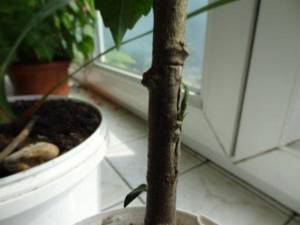
Prepare everything you need for vaccination:- sharp garden knife;
- blade;
- rooted cuttings as scion;
- polyethylene film;
- an adult, not old plant as a rootstock.
- The rootstock cut at the required height must be split in the center with a knife.
- The scion cutting must be sharpened into a wedge shape.
- Insert the scion cutting into the split.
- Wrap the grafting site tightly with plastic wrap, securing it tightly.
Seeds
Step-by-step landing instructions:
- Prepare what you need for sowing:
- container;
- substrate;
- drainage;
- seeds;
- spray bottle with water;
- glass or plastic film.
- Cover the bottom of the container with drainage, then a layer of moistened soil.
- The seeds are distributed over the surface at a distance of 0.5 cm from each other, sprinkled with a thin layer of substrate on top so that the seeds are buried 5 mm.
- Moisten the top layer generously with a spray bottle.
- The pot is covered with glass or polyethylene and placed in a warm, bright place, but without direct sunlight. Recommended maintenance temperature – +25С – +27С. The first shoots will appear in 2 - 3 weeks.
- It is necessary to maintain constant humidity in the greenhouse, do not forget to ventilate it and regularly spray the seeds and soil.
- When the seedlings have their first leaves, they need to be planted in individual pots.
- In mid-May, seedlings are planted in open ground.
Dividing the bush
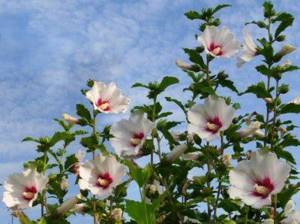
Step-by-step landing instructions:
- Prepare everything you need:
- sharp knife;
- pruner
- Dig up a bush.
- Carefully remove the soil from the roots (it is better to rinse it with water).
- Each trunk is separated with a knife so that each of them retains part of the roots (at least 1 - 2 roots 1 - 3 mm long).
- Using pruning shears you need to cut off all the soaked parts of the roots.
- Plant in pre-prepared planting holes.
Reproduction and cultivation of hibiscus can be done not only on the street, but also at home. You can learn more about this by reading the following articles:
- How to grow indoor hibiscus from seeds?
- Propagation of hibiscus by cuttings at home.
Reproduction
Caring for and propagating garden hibiscus is easy and simple. These processes do not require too much time and effort. Chinese roses are propagated in two ways: cuttings and seeds.
Propagation by cuttings
Cryptomeria japonica - indoor species and for growing in open ground
Cuttings are prepared in the summer. The blanks should have 3 internodes. The lower cut is treated with a root growth stimulator. The cuttings are planted in nutritious soil in a greenhouse or greenhouse and grow there until rooting. This process takes on average 1-1.5 months. After this, they are transplanted into containers, after the first leaves appear, they are pinched, and then planted in open ground in a permanent place.
Important! It is possible to germinate cuttings in cups with sweetened water.
Growing from seeds
Seeds should be sown in early spring. To prepare planting material, it must first be soaked in a dark pink solution of potassium permanganate for 10 minutes. After this, the seeds are immersed in a solution of epin or another root growth stimulator. Next you should follow the instructions:
- A substrate consisting of equal parts of peat and coarse river sand is poured into the container.
- The prepared seeds are slightly deepened at a distance of 4-5 cm from each other.
- The container is covered with plastic film or glass and placed in a warm place with a temperature of at least 27 °C.
- The shelter is periodically raised briefly to ventilate and moisten the soil (from a spray bottle).
- As soon as the first 2-3 leaves appear, the seedlings are planted in separate pots. It is worth making sure that young plants do not stretch out. If this happens, the flowers need additional lighting.
Important! When providing the seeds with an optimal temperature, it is better to ensure that the heating is from below.
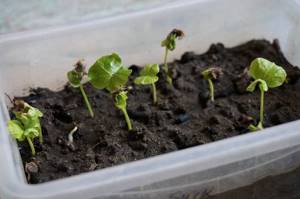
Chinese rose seedlings from seeds
Flowers are planted in open ground in May, when the threat of return frosts has passed. It is best to plant weak plants in open ground at the end of summer.
For your information! Some varieties of hibiscus, such as pink double hibiscus, can propagate by self-sowing.
When to fertilize and prune?
Attention! If the hibiscus was planted in the fall, then you should also mulch the soil around the trunk of the seedling and tie it with spruce branches or burlap with dead wood.
Hibiscus varieties grown in open ground are quite unpretentious and do not require special care. Systematic loosening of the top layer of soil, removal of weeds, regular watering (in hot and dry summers, watering should be daily) - this is what the plant requires. Twice a month, from June to September, garden hibiscus should be fed with fertilizers high in nitrogen and phosphorus, and in the fall with fertilizers with potassium. Don't forget about regular pruning of the plant.
Caring for hibiscus at home
How to care for a flower? Precisely because caring for indoor hibiscus at home does not require special skills and experience in growing plants, it is an excellent choice for beginners and those who do not have the opportunity to provide thorough and regular care. This unpretentious plant can withstand low temperatures and “put up” with insufficient lighting in the hall or living room, it is suitable for specific office conditions, and will also forgive improper watering. You can learn how to care for hibiscus in open ground here.
What to do if the plant does not take root?
- The rooted cuttings wither after transplanting into the ground. When planting a young plant, its root system was damaged. You will have to cut the hibiscus again, since such a cutting has practically no chance of survival. This phenomenon can be prevented if the cutting is transplanted using the transfer method: remove the plant from the old pot and, without shaking off the earthen lump, place it in an earthen hole.
- The plant did not bloom as expected. For systematic and abundant flowering, garden hibiscus needs regular pruning.
- Young garden hibiscus shows signs of infectious diseases (rot, powdery spots, etc.). To prevent this phenomenon, it is recommended to disinfect the soil and the pot in which the cuttings will be planted (fungicide treatment, heat treatment). You can also briefly immerse the seeds in a weak solution of potassium permanganate before soaking them in a growth stimulant solution.
Despite its exotic origin, hibiscus has long become “at home” in Russian latitudes. With a little effort, every gardener can grow and propagate this plant , bringing a little exoticism of hot countries into the design of their garden plot.
If you find an error, please select a piece of text and press Ctrl+Enter.
Reproduction of garden hibiscus
Propagating and planting hibiscus, as well as growing and caring for hibiscus, is not particularly difficult.
To propagate garden and tree hibiscus, you can use:
- layering;
- vaccinations;
- cuttings;
- seeds;
- dividing the bush.
Most often, gardeners use the third, fourth and fifth options.
Propagation by cuttings
The most optimal time for cuttings is early summer, before flowering begins.
How it's done:
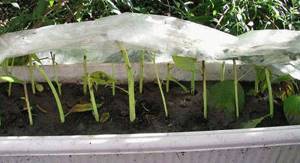
- Cut several shoots with 2-3 internodes.
- Dip their tips into a root growth stimulator.
- Plant in a prepared greenhouse filled with peat soil.
- Place it in a warm place.
- After about a month, when the cuttings have already taken root, transplant the seedlings into separate pots. Composition of soil for pots: leaf soil, peat, turf soil, sand - equal parts.
- Grow until a bush forms, watering regularly.
- Pinch the tops to encourage tillering.
- Replant in a prepared place in open ground.
Experienced gardeners can use ordinary water rather than soil for rooting. In this case, remove the main part of the foliage from the cutting, leaving only three or four leaves at the top. Cut a large leaf by 1/2 - this will reduce evaporation.
Dissolve activated carbon in water (1 tablet is enough) - this will protect it from rotting. After the roots appear, proceed according to the scheme given above.
Advice. Since young seedlings do not yet have the frost resistance inherent in adult plants, be sure to cover them for the winter, or better yet, dig them up, transplant them into containers and store them in the cellar until spring.
With proper care, the garden hibiscus plant will delight you with flowering in the same year.
Propagation by seeds
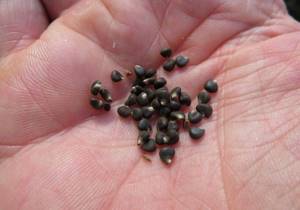
Some gardeners find it even easier to grow hibiscus from seeds than through cuttings.
The optimal time for sowing hibiscus seeds is late January-early March. It is advisable that the seeds be fresh; there is no need to stratify them.
- Dissolve potassium permanganate in water to make a dark pink solution, and place hibiscus seeds in it for 30 minutes.
- Keep the seeds in a growth stimulator for 24 hours.
- Mix peat and sand, water and sow the seeds.
- Place glass on the container or stretch transparent film to create a greenhouse effect.
- Place in a bright and warm place (t should not be below 25°C).
- Before emergence, regularly ventilate and water.
- After the first true leaves appear, pick up the seedlings.
Plant in a permanent place in the second ten days of May, after stable warm weather has established.
To protect seedlings from return frosts, cover them with covering material.
Keep in mind that garden hibiscus can also reproduce by self-sowing if you leave the seeds on the bush.
Reproduction by dividing the bush
This quick and convenient method is used to propagate mainly herbaceous varieties.
This way you can achieve lush flowering from the plant, as the bush is rejuvenated and thinned out.
How it's done:
- After the snow melts, as soon as the ground thaws, dig up a 3-4 year old bush.
- Using a knife or sharp shovel, divide the rhizome at the rate of: 1 trunk - 1 separate specimen.
- Dip the cuts in wood ash or crushed coal.
- Planting material cannot be stored for a long time; it must be immediately planted in a well-watered planting hole filled with a nutrient mixture.
- Cover the rhizomes with soil, compact them, and water again.
- After half a month, feed with nitrogen fertilizer.
If everything is done correctly, new shoots will soon appear and the plant will begin to actively develop. It will bloom this summer.
